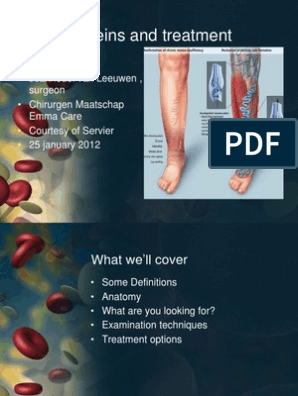0% found this document useful (0 votes)
340 views78 pagesDiseases of The Veins: Dr. Pisake Boontham M.D., Ph.D. Department of Surgery Phramongkutklao Hospital
The document discusses diseases of the veins, focusing on varicose veins and deep vein thrombosis (DVT). It describes the anatomy of leg veins, noting the superficial and deep venous systems connected by perforating veins. Varicose veins result from valve failure in superficial veins, allowing blood to pool. Risk factors include heredity, prolonged standing, pregnancy, and western lifestyle. Symptoms range from none to leg pain and swelling. Treatment includes compression therapy, sclerotherapy, vein stripping surgery, and endovenous laser ablation. DVT is common in hospitalized patients and risks include immobility and hypercoagulable states. Prevention focuses on early mobilization and compression stockings while treatment involves anticoagulation
Uploaded by
getnusCopyright
© Attribution Non-Commercial (BY-NC)
We take content rights seriously. If you suspect this is your content, claim it here.
Available Formats
Download as PPT, PDF, TXT or read online on Scribd
0% found this document useful (0 votes)
340 views78 pagesDiseases of The Veins: Dr. Pisake Boontham M.D., Ph.D. Department of Surgery Phramongkutklao Hospital
The document discusses diseases of the veins, focusing on varicose veins and deep vein thrombosis (DVT). It describes the anatomy of leg veins, noting the superficial and deep venous systems connected by perforating veins. Varicose veins result from valve failure in superficial veins, allowing blood to pool. Risk factors include heredity, prolonged standing, pregnancy, and western lifestyle. Symptoms range from none to leg pain and swelling. Treatment includes compression therapy, sclerotherapy, vein stripping surgery, and endovenous laser ablation. DVT is common in hospitalized patients and risks include immobility and hypercoagulable states. Prevention focuses on early mobilization and compression stockings while treatment involves anticoagulation
Uploaded by
getnusCopyright
© Attribution Non-Commercial (BY-NC)
We take content rights seriously. If you suspect this is your content, claim it here.
Available Formats
Download as PPT, PDF, TXT or read online on Scribd
/ 78





























































































